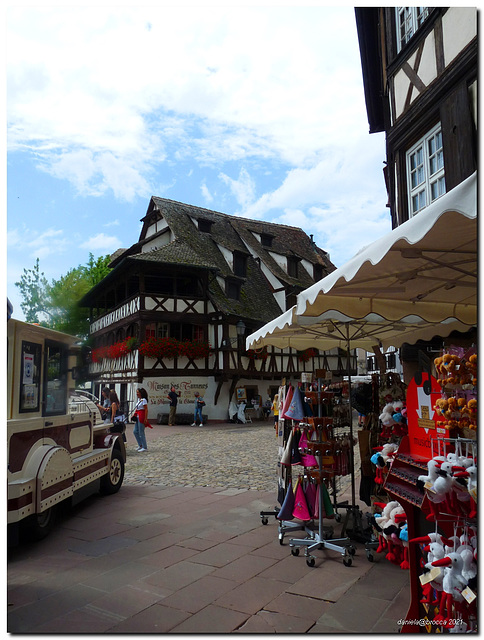Barrage Vauban
Fiume Ill nella Petite France
Torri e ponti coperti
Nella Cattedrale
Cattedrale di Notre Dame- Colonna degli angeli
Dettaglio dell'orologio astronomico
Dettaglio dell'orologio astronomico
L'orologio astronomico
Interno della cattedrale
Bateau mouche Batorama
Les pieds dans l'eau
Quai des Bateliers
Petit train touristique
Cathédrale
Carousel en Place Gutenberg-Strasbourg
Ribeauvillé- il paese delle cicogne
Cicogna nel nido
Cicogna su un comignolo
Pifferaio
Botti
Cicogne sul comigliolo e nel nido
Grande Rue
Pifferaio e lampione
Tipica casa a traliccio
Ancienne douane
Pont du Corbeau et musée historique de la ville de…
Grande Île- Fiume Ill
Quasi a Strasburgo
Ponte napoleonico sul Diveria a Crevola
Crevola-Chiesa SS.Pietro e Paolo
Probabile casa del direttore della centrale
Centrale idroelettrica- Dettaglio
Centrale idroelettrica Crevola Toce
Varzo, la valle e il Toce
Ponte del Diavolo a Trasquera
A lot of flowers
Stalla con capre- Stable with goats
Rooster and hens
Nice house
Mura della torre
Ilda e io davanti al lavatoio
Municipio
Viale alberato
Casa di riposo
Ilda verso la casa di riposo
See also...
Keywords
Authorizations, license
-
Visible by: Everyone -
All rights reserved
-
146 visits
Maison des tanneurs- Casa dei conciatori


LA PETITE FRANCE
E' il quartiere più pittoresco della vecchia Strasburgo, un tempo quartiere dei pescatori, dei mugnai e dei conciatori. Le sue stradine offrono un susseguirsi di case a travi apparenti risalenti ai secoli 16° e 17° secolo, di vasti cortili interni, di alti tetti spioventi, aperti su granai dove un tempo erano messe a seccare le pelli. Il suo nome deriva da una malattia venerea, che si contraeva durante le guerre (i francesi la chiamavano il "male napoletano", gli strasburghesi "il mal francese"): in questo luogo sorgeva infatti un ospedale per curare questa malattia, detto "Zum Franzosel", appunto la piccola Francia. L'ospedale è andato distrutto, mentre è rimasto il nome del Quartiere.
La Rue du Bain-aux-Plantes è stata per alcuni secoli il quartiere della corporazione dei conciatori ed è fiancheggiata da vecchie case rinascimentali alsaziane (16°-17° secc) a travi apparenti con pinnacoli e terrazze. Al n. 42 la casa dei conciatori ("Gerwerstub") del 1572, mentre sul lato opposto i nn. 33 (all'angolo di Rue du Fossé-des-Tanneurs e di Rue des Cheveux (strettissima)), 31, 27, 25 del 1651.
---------------------------------------------------------------------------
LA PETITE FRANCE
This is the most picturesque quarter of old Strasbourg, once the quarter of fishermen, millers and tanners. Its narrow streets offer a succession of houses with apparent beams dating back to the 16th and 17th centuries, vast inner courtyards, high sloping roofs, opening onto barns where hides were once dried. Its name derives from a venereal disease contracted during wars (the French called it the "Neapolitan disease", the people of Strasbourg the "French disease"): there used to be a hospital here to treat this disease, called "Zum Franzosel", meaning "little France". The hospital was destroyed, but the name of the district has remained.
Rue du Bain-aux-Plantes was for several centuries the quarter of the tanners' guild and is lined with old Alsatian Renaissance houses (16th-17th centuries) with apparent beams, pinnacles and terraces. At number 42 is the tanners' house ("Gerwerstub") from 1572, and on the opposite side numbers 33 (on the corner of Rue du Fossé-des-Tanneurs and Rue des Cheveux (very narrow)), 31, 27, 25 from 1651.
Translated with www.deepl.com/Translator (free version)
E' il quartiere più pittoresco della vecchia Strasburgo, un tempo quartiere dei pescatori, dei mugnai e dei conciatori. Le sue stradine offrono un susseguirsi di case a travi apparenti risalenti ai secoli 16° e 17° secolo, di vasti cortili interni, di alti tetti spioventi, aperti su granai dove un tempo erano messe a seccare le pelli. Il suo nome deriva da una malattia venerea, che si contraeva durante le guerre (i francesi la chiamavano il "male napoletano", gli strasburghesi "il mal francese"): in questo luogo sorgeva infatti un ospedale per curare questa malattia, detto "Zum Franzosel", appunto la piccola Francia. L'ospedale è andato distrutto, mentre è rimasto il nome del Quartiere.
La Rue du Bain-aux-Plantes è stata per alcuni secoli il quartiere della corporazione dei conciatori ed è fiancheggiata da vecchie case rinascimentali alsaziane (16°-17° secc) a travi apparenti con pinnacoli e terrazze. Al n. 42 la casa dei conciatori ("Gerwerstub") del 1572, mentre sul lato opposto i nn. 33 (all'angolo di Rue du Fossé-des-Tanneurs e di Rue des Cheveux (strettissima)), 31, 27, 25 del 1651.
---------------------------------------------------------------------------
LA PETITE FRANCE
This is the most picturesque quarter of old Strasbourg, once the quarter of fishermen, millers and tanners. Its narrow streets offer a succession of houses with apparent beams dating back to the 16th and 17th centuries, vast inner courtyards, high sloping roofs, opening onto barns where hides were once dried. Its name derives from a venereal disease contracted during wars (the French called it the "Neapolitan disease", the people of Strasbourg the "French disease"): there used to be a hospital here to treat this disease, called "Zum Franzosel", meaning "little France". The hospital was destroyed, but the name of the district has remained.
Rue du Bain-aux-Plantes was for several centuries the quarter of the tanners' guild and is lined with old Alsatian Renaissance houses (16th-17th centuries) with apparent beams, pinnacles and terraces. At number 42 is the tanners' house ("Gerwerstub") from 1572, and on the opposite side numbers 33 (on the corner of Rue du Fossé-des-Tanneurs and Rue des Cheveux (very narrow)), 31, 27, 25 from 1651.
Translated with www.deepl.com/Translator (free version)
bonsai59, Pano ☼ Rapi ♫✯♫, Nick Weall, Erhard Bernstein have particularly liked this photo
- Keyboard shortcuts:
Jump to top
RSS feed- Latest comments - Subscribe to the comment feeds of this photo
- ipernity © 2007-2025
- Help & Contact
|
Club news
|
About ipernity
|
History |
ipernity Club & Prices |
Guide of good conduct
Donate | Group guidelines | Privacy policy | Terms of use | Statutes | In memoria -
Facebook
Twitter

Daniela Brocca club has replied to "JohnNymer" clubDaniela Brocca club has replied to bonsai59 clubSign-in to write a comment.